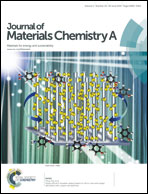Macroporous metal–organic framework microparticles with improved liquid phase separation†
Abstract
Typically, metal–organic frameworks (MOFs) exhibit ordered micropores (<2 nm). The control of pore shape, surface functionality and high surface area, which comes with the variety of metal ions and enormously available organic ligands, has rendered a wide range of applications for MOF materials. Due to the limited mass transport of micropores, various approaches have been developed to produce mesoporous MOFs. However, the preparation of macroporous MOFs (with macropores in addition to the micropores) has been scarce, despite this type of material being able to facilitate considerably applications such as separation and catalysis. Here, we report the solvothermal modification of HKUST-1 microparticles with hydroquinone. An etching mechanism is suggested for the formation of macroporous HKUST-1 particles, which presents a high surface area and high macropore volume with the HKUST-1 characteristic pattern. Single X-ray diffraction data shows a cubic unit cell eight times the size of the HKUST-1 unit cell, as a result of slight distortions to the framework. The modified macroporous HKUST-1 particles are further packed into a column, showing fast and improved separation of ethylbenzene and styrene by high performance liquid chromatography.


 Please wait while we load your content...
Please wait while we load your content...